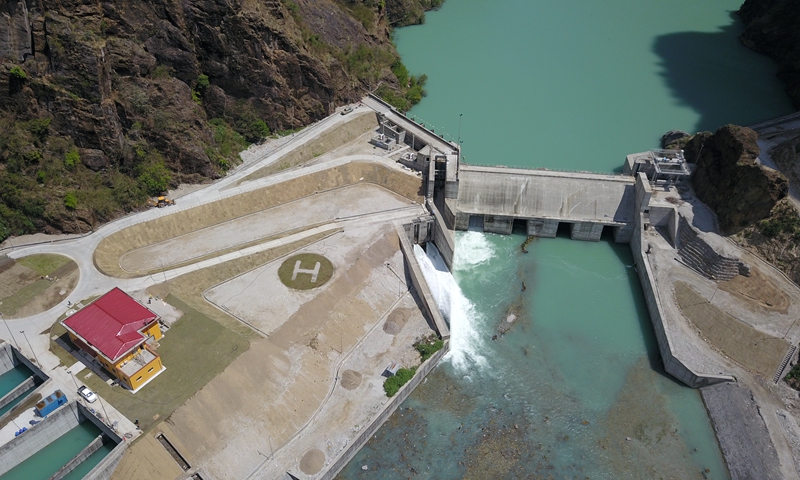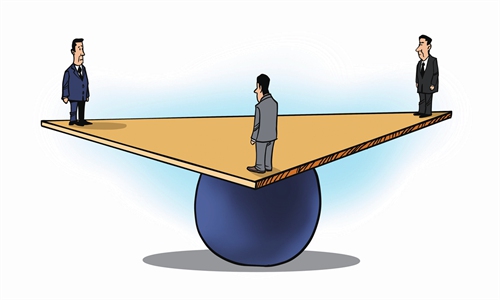IN-DEPTH / IN-DEPTH
Can India's attempts to squeeze Chinese investment in Nepal's energy sector succeed?

An aerial photo of the dam of the upper Tamakoshi hydroelectric project in Nepal Photo: Courtesy of PowerChina
With Nepal's Prime Minister Pushpa Kamal Dahal concluding his recent visit to India, India's influence in Nepal's energy sector has further increased, as the two sides reportedly signed seven agreements to boost cooperation in areas including trade and energy. Indian Prime Minister Narendra Modi announced plans for an increase in the import of power from Nepal to India to 10,000 MW within the next 10 years.
India's ambition in Nepal's energy sector is widely seen as an effort to control Nepal's economic lifeline and compete with another major investor, China, by launching relevant policies to indirectly block Chinese elements in Nepal's hydropower industry.
Experts said that India is seeking to re-establish regional hegemony in South Asia through various means, including using Nepal's electricity as a tool.
However, India's attempt to make China withdraw from the forefront of Nepal's development cannot hinder cooperation between China and Nepal. Observers said that China is sincerely helping Nepal to develop its economy and infrastructure, rather than using Nepal's resources as strategic pawns for control.
A great contribution
Nepal, a landlocked mountainous country in South Asia, borders China on the north and India on the other three sides. Nepal is rich in hydropower resources, and its hydropower reserves account for about 2.3 percent of the world's total hydropower reserves. In the past decade, with the participation of Chinese enterprises, Nepal is moving toward becoming "a net exporter of power."
About 10 years ago, Nepal had very limited power supply. In 2019, when Global Times reporters visited Nepal, there were sometimes two power outages in one day, and the local people were not surprised by the blackouts.
Nowadays the power generation and supply situation in Nepal has been greatly improved, and the country aims to enable secure access to electricity for all its people by 2024.
Chinese companies have made outstanding contributions in this improvement of local electricity supply in the past 10 years.
For example, the Upper Marsyangdi A hydropower station in Nepal, which began operation in September 2016, was the first project developed, built, and operated by a Chinese company in Nepal. The power station provides a long-term and stable power source for Kathmandu and the famous tourist city of Pokhara. In November 2022, the Nepalese government also awarded the power station a special contribution award for the hydropower industry.
In March last year, the Upper Tamakoshi Hydroelectric Project, the largest hydroelectric project in Nepal, was fully put into operation with the involvement of a Chinese company. It has been reported that the total installed capacity of the project will reach 456 MW and the entire project will contribute about 1 percent of Nepal's GDP.
However, due to the distinct dry and wet seasons, if the country wants to build enough hydropower plants to meet its domestic demand during the dry season, it will inevitably generate excess electricity in the wet season. The electricity can be wasted if there are no foreign buyers, which in turn will discourage enthusiasm for investment in hydropower projects in Nepal.
In order to avoid waste of excess power, Nepal needs to find overseas markets. Its key target markets in South Asian are India and Bangladesh. Currently, India has allowed Nepal to sell 452.6 MW of electricity generated by 10 hydropower projects in the Indian power market. As for the electricity trade between Nepal and Bangladesh, India's attitude is also crucial.
The Global Times learned that in April 2021, the Nepal Electricity Authority (NEA) was approved by India to enter its electricity trading market. In November 2021, the Central Electricity Authority of India agreed to buy electricity produced by two hydropower projects in Nepal, both developed by India. Since then, Nepal started to sell excess electricity to India during wet season, and import electricity from India during dry season.
In 2022, Nepal earned approximately 12 billion rupees (about $91 million) from exporting electricity to India, according to Suresh Bhattarai, spokesperson for the NEA.
Nepal's energy authority said that the country, unlike in past years, will have more exports than the imports, which means it will be a net exporter of power in terms of both volume of energy and earnings.
Discouraging Chinese firms
India struck an electricity buying deal with Nepal in 2014, but changed its own policy in 2018 to prevent the purchase of power produced via the investment of nations with which it does not have a "bilateral agreement on power sector cooperation," Reuters reported. This means India and its companies cannot buy hydropower produced by Chinese-funded or Chinese-built plants.
This has left Kathmandu with little choice but to bow to New Delhi over the future of its hydropower sector, several experts said.
Since India's power purchasing shift, Nepal has removed Chinese developers from six hydropower projects and given four hydro contracts to Indian companies, the Reuters report cited an official from Nepal's water resources and irrigation ministry as saying.
Chinese-invested electric power capacity in Nepal has been facing difficulties in accessing the Indian electric power market, which has dealt a blow to Nepal's hopes of earning revenue through electricity exports and discouraged investment cooperation between Chinese enterprises and Nepal.
The head of a large Chinese enterprise involved in investment in Nepal's hydroelectric projects told the Global Times on condition of anonymity that India has been exerting pressure on Nepal in the industry through various means, creating certain obstacles to Chinese investment and contract signing.
"The Indian government is very sensitive to water and power station projects in Nepal that are invested in, financed, or contracted by Chinese enterprises, and the Indian government is gradually increasing its investment in hydropower stations in Nepal. However, the Indian government currently has only started one of its projects. India aims only to get control of Nepal's resources, rather than truly helping them develop it," said the anonymous source.
Chinese companies reportedly had shown little interest in participating in the Power Summit on April 18 and 19, 2023 in Kathmandu, the Kathmandu Post reported citing the event's organizer. "We have sent invitations through diplomatic missions to foreign companies, including those in China. We have also invited individual companies," said Ganesh Karki, vice-president of organizer. "But no Chinese company nor their representatives have confirmed their participation."
However, representatives of some Chinese companies in Nepal refuted the claim and told the Global Times recently that they had never received any invitation.
"The policy change is also reflected in changes in China-India relations. The confrontation between China and India in Doklam in 2017 was an important moment when the relations turned cold," Sun Xihui, an associate research fellow with the National Institute of International Strategy at the Chinese Academy of Social Sciences, told the Global Times on Friday.
The border issue between China and India is an important factor leading to the deepening of India's hostility toward China, he noted. India regards China as its biggest strategic competitor and its biggest external threat. It hopes to exclude China's influence in Nepal through this policy in the field of hydropower, said Sun.
India has "tried to control the way Chinese investments were coming to Nepal," Dwarikanath Dhungel, former secretary of the Ministry of Water Resources of Nepal, told the BBC in a report on May 30. He said that India wants the Chinese not to have influence in the water resources sector in Nepal and that the projects should be under their control.
A visiting fellow of India's Observer Research Foundation discussed the issue in an article titled "India putting China on its backfoot in Nepal" in April. "Apart from increasing its engagement with Nepal, India is silently trying to check China's growing influence in Nepal through economic diplomacy," the article said.
Facing this policy, it is important to construct a cross-border power grid between China and Nepal, Roshan Khadka, editor-in-chief of the Nepalese news website Kathmandpati, told the Global Times.
According to him, except for some hydropower projects backed by India and built by Nepal, none of the hydropower projects directly invested in by Indian companies have been completed yet.
"Recently, infrastructure accidents in India have frequently occurred, such as the collapse of the bridge in Bihar, and the railway collision in Odessa. These events reflect the inadequacy of India's infrastructure construction capabilities, and to a certain extent show that India's infrastructure level in the field of hydropower will also be relatively poor," said Sun.
Sun said that in order to cope with this situation, the building of a cross-border power grid between China and Nepal should be discussed as soon as possible.
"On the one hand, when Nepal is short of electricity in dry season, China can sell its electricity to Nepal to make up for Nepal's electricity shortage. When Nepal has sufficient electricity, China can buy surplus electricity from Nepal. It helps Nepal reduce its dependence on India."
The China-Nepal cross-border power grid has seen progress as it completed the on-site electrical testing work in Nepal on February 24. In January, the Nepalese project director of the China-Nepal cross-border power grid interconnection project told the local media that the project is crucial for attracting Chinese investment in Nepal's hydropower industry and selling electricity to China. The 70-kilometer project that can carry 5,000 MW of electricity across the border will open the door to electricity trade between the two countries.
In February, at an event to promote investment opportunities in Nepal's energy sector held at the Nepalese embassy in China, Nepalese Ambassador to China Bishnu Pukar Shrestha stated that Nepalese government has formulated various policies to attract foreign investment, from countries including China. Shrestha gave the example that Nepal has abundant water resources, but the development is insufficient, and the potential of water resources needs to be released urgently to promote national economic development and improve people's living standards.
China has always been supportive of Nepal's water resources development via the Belt and Road Initiative (BRI) which gets operated in an open and transparent manner according to market rules and fair principles, Chinese Ambassador to Nepal Chen Song said at a forum on March 16. Chen said that the BRI is not a "solo" by China alone but a "chorus" by all parties.
China has been the largest source of foreign investment in Nepal for seven consecutive years, and Chinese investment has created more than 100,000 jobs in Nepal.
Laxman Biyogi, the editor of a Nepalese energy magazine, told the Global Times that Nepal not only needs Chinese investment in the hydropower industry but also in renewable energy such as solar and wind power. The space for cooperation between China and Nepal in reducing carbon emissions is still very large.

